Quiz UNIT 1 Questions
1/28
There's no tags or description
Looks like no tags are added yet.
Name | Mastery | Learn | Test | Matching | Spaced |
|---|
No study sessions yet.
29 Terms
Which correspond(s) to benefits of sexual reproduction?
A. Avoiding the two fold cost of males
B. Increased costs of mate searching
C. Being able to keep up in the red Queen arms race
D. A and B
E. A and C
C
Asexual reproduction is more competitive in the evolutionary short-term because:
A. Population growth has the potential to be faster in asexual populations
B. Offspring in sexual populations can inherit mutations from both parents
C. Asexual populations are more likely to accumulate beneficial alleles
D. A and B
E. A and C
A
Muller’s rachet is a problem for asexual populations because:
A. Drift eliminates lineages with the least number of deleterious mutations
B. Mutations do not accumulate as rapidly in asexual reproducers
C. Reshuffling alleles can break up favorable allele combinations
D. Mutational load decreases each generation due to selection
A
The majority of which group(s) reproduce asexually and how can they avoid costs of asexual reproduction?
A. Prokaryotes, they have robust DNA repair mechanisms
B. Eukaryotes, they usually can sexually reproduce when needed
C. Plants, they are able to live for a long time
D. All of these
E. None of these
A
Which of the following statements are true?
A. It is hard to explain why sexual reproduction persists because of the associated costs
B. It is hard to explain why asexual reproduction evolves over the short-term because it is so costly
C. It is fairly easy to explain the evolutionary transition from sexual to asexual reproduction, but not its long term persistence
D. A and B
E. A and C
C
Pathogens can favor the evolution of sexual reproduction because:
A. Novel allele combinations should increase the likelihood of being resistant to pathogen infection (this is the idea behind the red queen hypothesis...and the less common any given allele combination is, the less likely the pathogen will be good at infecting the individual with it)
B. Clones that are successful should continue being successful (this is true for abiotic environments, but not for biotic (living...i.e. pathogens) environments)
C. Mutations that occur in clones will be mostly beneficial (regardless of what type of individual has a mutation, mutations on average are neutral to slightly deleterious)
D. A&B
E. All of the above
A
When mutation rates increase in a population that is capable of reproducing sexually and asexually, what is most likely to happen and why? (100%)
A. sexual reproduction would increase to escape the Red Queen Hypothesis
B. sexual reproduction would decrease because of the Red Queen Hypothesis
C. sexual reproduction would increase because recombination can get rid of deleterious mutations
D. sexual reproduction would decrease because recombination can get rid of deleterious mutations
E. none of the above
C
What are the macroevolutionary consequences and patterns related to the evolution of asexual and sexual reproduction? (93%)
A. Asexual lineages tend to go extinct rather quickly
B. It is easier to identify species in asexuals because there is direct inheritance of genetic material from one generation to the next
C. Asexual populations tend to be evolutionarily relative young and on the tips of the phylogeny
D. A&B
E. A&C
E
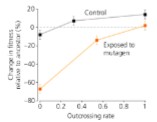
Which concepts does this graph support and why? (81%)
A. Escaping The Red Queen Hypothesis because it shows that sexual reproduction is beneficial when parasites are present (this graph shows that increased mutation rates favor higher outcrossing...because higher outcrossing helps purge deleterious mutations. Parasites don’t factor into this graph)
B. Avoiding Muller’s Rachet because it illustrates increased fitness of sexual reproduction due to purging deleterious mutations when mutation rates are high (this graph shows an increase in fitness the higher the outcrossing rate, which means the greater the rate
of sexual reproduction. It does not show anything to do with time or parasites, and the mutagen induces mutations. These mutations will be neutral to slightly deleterious and don’t have as much of an effect in the presence of sexual reproduction because they are purged in meiosis)
C. Changes in fitness over time, because both sexual and asexual organisms have higher
fitness the longer selection acts to shape performance (this graph doesn’t have time on it)
D. A&B
E. None of these
B
Asexually reproducing populations can have higher fitness in stable environments because:
A. Muller’s ratchet leads to the accumulation of beneficial alleles in the population that are
matched to that environment
B. They avoid recombination that breaks up adaptive gene complexes
C. Pathogens don’t evolve when environments are stable (pathogens CONSTANTLY
evolve...because the primary part of the environment they adapt to are living
organisms...hosts...that also constantly evolve in response to the pathogens!)
D. A&B
E. All of the above
B
Sex-allocation theory predicts: (69%)
*A. A 50:50 sex ratio for all organisms with two sexes (this is usually the case, but the two sexes
are not equal to make for all organisms with two sexes)
B. When male offspring are more expensive to produce than female offspring, then a
population will have more females than males (you put equal into both sexes, so if one costs
more, you can make fewer)
C. When male offspring are more expensive to produce than female offspring, then a population
will have more males than females (you would have fewer)
D. A&B
E. A&C
B
Bluehead wrasse Terminal Phase (TP) males experience very high reproductive success. Yet, only a small percentage of the population is TP males. Why? (85%)
A. TP males suffer high costs that can only be offset by sneaking copulations (the high costs are offset by the fact they get many many copulations and very high reproductive success)
B. The size-advantage model of sex determination predicts that females will only switch to TP males when they are big enough to be reproductively competitive and very few individuals are large enough to be reproductively competitive as TP males
C. The benefits of being a female outweigh the costs of being male regardless of size (in fact, the benefits of being a female are greater when the female is smaller..otherwise it is worth the risk of being a TP male if you are big)
D. None of the above
E. All of the above
B
Which of the following statements are true? (65%)
A. Asexual reproduction does not often persist over the evolutionary long term, even though it may evolve numerous times (because the red queen hypothesis and muller’s ratchet decrease mean fitness in asexual populations over time)
B. In asexually reproducing populations, it is easy to determine distinct species because each lineage is genetically distinct (this actually makes it harder to determine species boundaries)
C. Because of short-term costs of asexual reproduction, it does not evolve often. (the opposite is true, it has short-term advantages, but long-term costs)
D. A&B
E. B&C
A
Why are Bdelloid rotifers considered “paradoxical” asexuals? (85%)
A. They are not able to produce offspring more quickly relative to sexual organisms (they produce offspring more quickly than sexuals because they can clone themselves)
B. They are not susceptible to mutation accumulation (they are susceptible to mutation accumulation, but what make then paradoxical is that they have persisted for millennia, when we expect them to have shorter evolutionary lives)
C. They have persisted as asexuals for millions of years despite asexuals typically being form younger lineages
D. None of the above
C
Which of the following is true about the evolution of sex determination mechanisms? (42%)
A. Just a few types of sex determination mechanisms exist, but they have evolved multiple times. (many exist and they have evolved numerous times)
B. Sex determination requires differences in gene expression due to different genetics in males and females. (yes, they involve changes in gene expression, but it can be due to genetic differences,environmental differences, or a mix).
C. Sex determination always involves ecologically-driven changes in gene expression across the sexes. (they involve gene expression changes, but it does not have to be from ecological or
social cues, it can be driven by genetic differences)
D. A sex-determination mechanism is necessary in order for sexual reproduction to purge deleterious mutations. (you can have mating types and not different sexes, and still be able to purge deleterious mutations)
E. None of the above
E
When would selection favor sex ratios to deviate from an average of 50:50? (50%)
A. The cost of producing a male differs significantly from the cost of producing a female (if the costs of producing one sex differ from the other, you would make different amounts of each)
B. When sex determination is environmentally determined (if it is environmentally determined, and a populations ends up making an abundance of one sex, then selection will favor an evolutionary
shift in the population...)
C. A&B
E. Neither, sex ratios should always be 50:50
A
Some species change sex over their lifetime because: (96%)
A. Reproductive output is higher when individuals are larger (this can be true, and often is, but will favor sex change only if one sex is better when larger and the other sex is better when smaller)
B. The costs and benefits of being one sex or the other change depending on the other competitors in the environment.
C. Sex chromosomes can change over an individual’s lifetime
D. None of the above
B
What do all sex determination mechanisms all have in common? (81%)
A. Males and females have at least one gene that differs even if they don’t have distinct sex chromosomes (they can have the exact same genome, but experience different environments)
B. Gene expression differs between males and females (males and females can have the same exact genetic background, and some environmental factor can determine if they are male or female. This happens when temperature affects sex as well as the social environment like in the blueheaded wrasse.)
C. Both of the above
D. Neither are found in all sex determination mechanisms (no matter what, you have to have a difference in gene expression, otherwise there would be no distinction between the sexes)
B
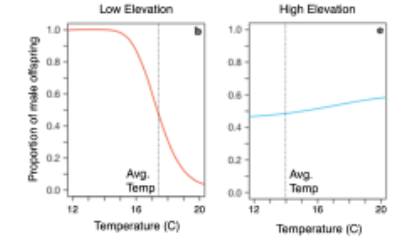
Which of the following precedes the evolution of gametes of different sizes? (88%)
A. Gametes that differ in shape can fuse (mating types do not differ in shape, and sexual reproduction has to evolve before specialization of gametes)
B. Gametes of different mating types can fuse (this is isogamy, which is the precursor to anisogamy)
C. Hermaphrodites take distinct reproductive strategies (hermaphrodites evolved after anisogamy)
D. All of the above
E. None of the above
D

If the sexes in the species from the graph followed traditional sex roles, which symbols/line most likely represent the relationship between mating and reproductive success for males?
A. The dotted line and black circles
B. The solid line and open squares
C. Not enough information to make a guess
B
What can females gain from mating with multiple males?
A. Greater genetic diversity in offspring
B. Direct benefits, like protection or food
C. Greater chance that at least one male is genetically compatible.
D. A&C
E. All of the abovve
E

Given the following graphs showing the relationship between mating success and reproductive success in males (solid lines) and females (dotted lines), in which population is sex role reversal most likely?
A. A
B. B
C. C
D. A&C
E. B&C
A
What factors shape how strongly males or females are likely to compete for mates?
A. Body size of both sexes
B. Body size of males relative to females
C. Nutritional investment in the offspring
D. A&B
E. All of the above
C
Why might monogamy (or social monogamy) be favored by selection?
A. Biparental care increases offspring survival
B. Mating with more than one mate increases offspring genetic diversity
C. Bateman’s gradient is steep for females
D. A&C
E. All of the above
A
In which mating system(s) is there high reproductive skew (i.e. high variance in mating success) in males because females group together to share social information with each other?
A. Territory defense polygyny
B. Lek polygyny
C. Harem defense polygyny
D. A&C
E. All of the above
C
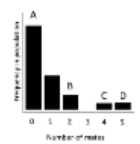
Which of the following could result in the spread of mating success in
males in the graph to the right? (ignore capital letters in graph)
A. Lek polygyny
B. Highly variable resources coupled with male territory defense
C. High parental investment needed to rear offspring
D. A&B
E. All of these
D
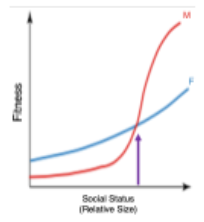
Given the graph to the right where M corresponds to male and F corresponds to female, what is true in this population?
A. Fitness increases the larger you are relative to others in
the population.
B. Selection is likely to favor a change from female to male
at a set age
C. Sex change provides a mechanism by which the sex
ratio remains stable in the populations
D. A&C
E. All of the above
D
Why might a mating system vary across populations or species?
A. Resources vary in how clumped or disperse they are across populations
B. Resources vary in abundance across populations
C. The degree of investment in offspring by males and females varies across populations
D. A&B
E. All of the above
E
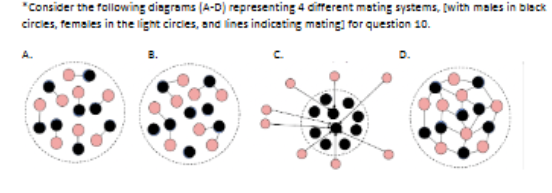
Which of the above mating system(s) are most likely to favor strong competition in males?
A. A
B. B
C. C
D. A&B
E. B&C
E